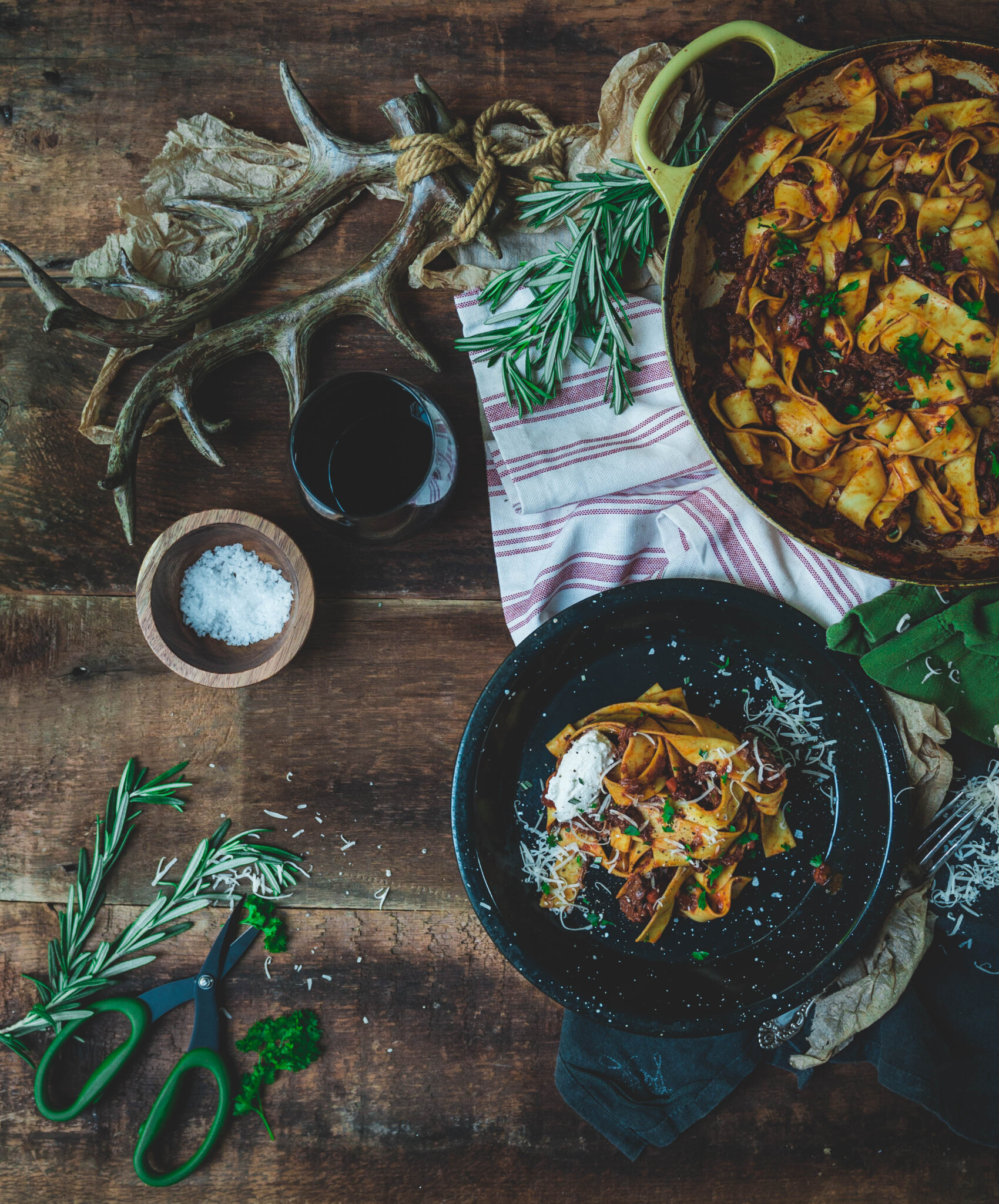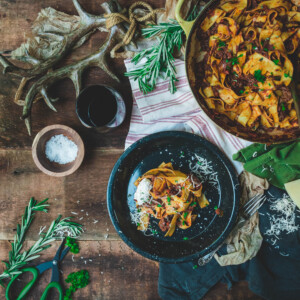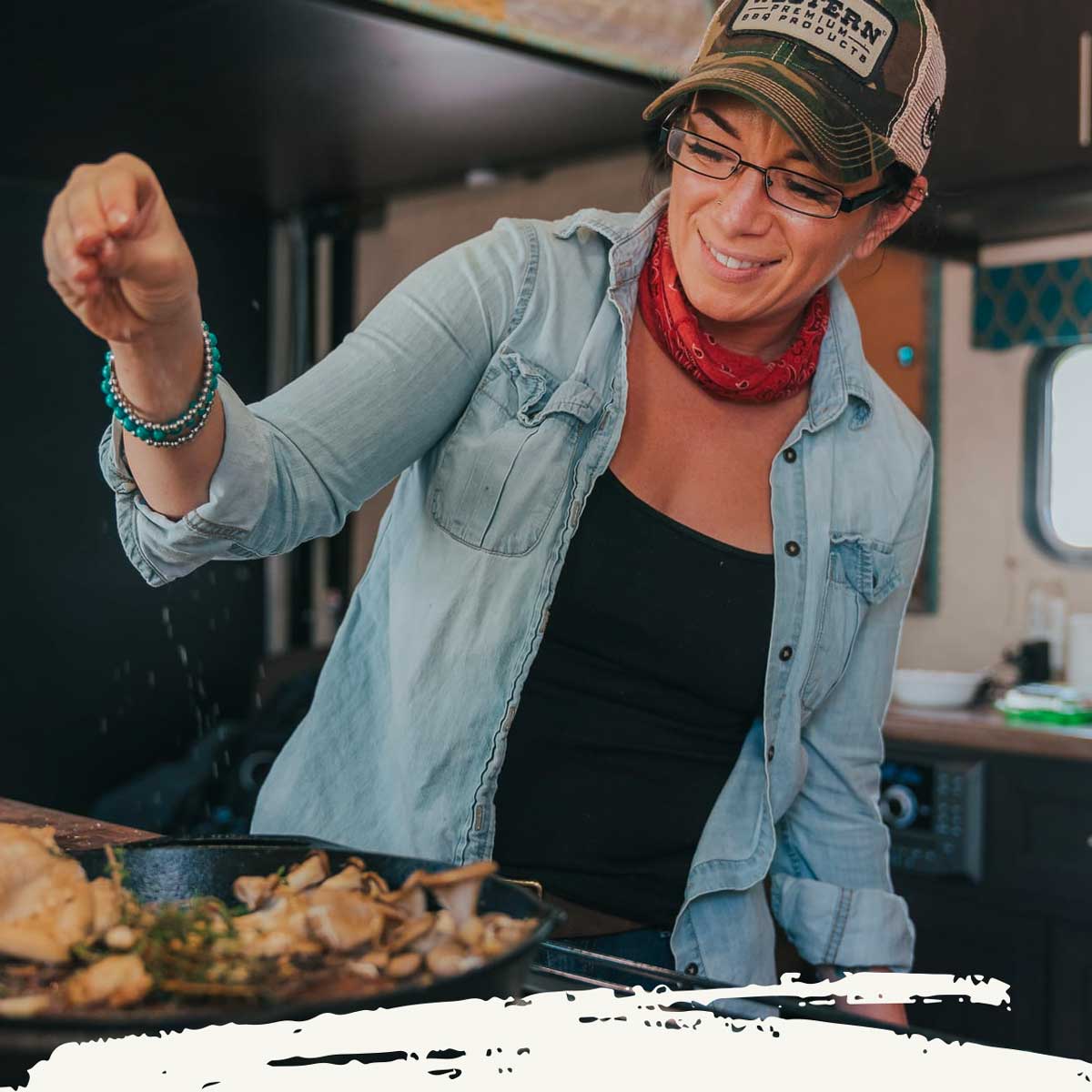Succulent and tender beef, a savory meat sauce, and oodles of noodles – what’s not to love about this Braised Beef Cheek Ragu? Topped with a dollop of ricotta and plenty of fresh Parmesan, this amazing dish is so flavorful you’re sure to love it!

Table of Contents
- Save This Recipe ✉️
- What Are Braised Beef Cheeks?
- Ragu vs. Bolognese – What’s the Difference?
- Slow Braised Beef Cheek Ragu Ingredients
- How to Make Ragu with Beef Cheeks
- Girl Carnivore Expert Recipe Tips
- What to Serve With Beef Cheek Ragu
- Leftovers & Reheating
- MORE BRAISED meat RECIPES
- Save This Recipe ✉️
- Braised Beef Cheek Ragu Recipe
In this recipe:
We love this dish. As much as we love grilling and smoking and cooking outdoors, the weather doesn’t always cooperate. With a cooked-low-and-slow dish like this, we can still enjoy big and bold flavors of beef recipes made in the kitchen. Plus, it’s an absolutely delicious dish that we look forward to making again and again!
This dish is a labor of love; it’s not a quick fix. But the results are oh-so-worth-it! Succulent and fall-apart tender slow-cooked beef cheeks, al dente noodles, and flavor through and through make this one of our favorite Italian pastas. If you don’t care for pasta or want a gluten-free alternative, pair this ragu with buttery mashed potatoes.
If you love Italian cuisine, you’ll love our Easy Pork Meatballs and Pork Belly Porchetta Roast!
What Are Braised Beef Cheeks?
The star of this Beef Cheek Ragu recipe is beef cheeks. Beef cheeks are a specialty cut, and they are literally the facial cheeks of a cow or ox. It’s a heavily used muscle, so there’s lots of tough sinew. But, when you cook them slowly in liquid – braise them – they become tender and delicious.
You’ll need to get beef cheeks from your local butcher and call them ahead of time because most butchers don’t stock them, but they’ll be happy to bring them in for you.

Ragu vs. Bolognese – What’s the Difference?
First, a ragu is a stew – an Italian stew. Bolognese CAN be a ragu, but a ragu is not a Bolognese. There are some significant differences:
- Ragu is a meat-based sauce with a small amount of sauce, and Bolognese is sauce-based.
- Ragu has more meat, generally larger chunks, than a Bolognese.
- Both ragu and Bolognese feature a sofrito, a combination of minced carrot, celery, onion, and sometimes pancetta, but a ragu typically has more soffritto than a Bolognese.
- There are hundreds of variations of both ragus and Bolognese sauces.
Ragus can be made with various cuts of beef, pork, goose, lamb, mutton, and even seafood. We’re using beef cheeks because they are perfect for braising, but you could use leftover smoked chuck roast for a unique smoky flavor.

Slow Braised Beef Cheek Ragu Ingredients
There are a fair number of ingredients in this beef cheeks recipe, but other than the beef cheeks themselves, most are commonly available. Don’t forget about the delish garnishes – each adds flavor and texture to the beef cheek stew, transforming it from simple peasant fare to something worthy of the finest Italian restaurants.
- Beef cheeks – You’ll need about 2 pounds. Order them ahead of time from your butcher.
- Salt – Any coarse salt will do.
- Olive oil – Or use your favorite cooking oil.
- Onion – Fresh yellow or white onions.
- Carrot
- Celery
- Garlic – Fresh garlic is essential.
- Red pepper flakes – Adds a bit of spice.
- Itlanial Seasoning – bright, herbaceous blend
- GirlCarnivore Ooomami or Mushroom Powder – adds rich umami depth.
- Tomato paste – To help build flavor.
- Red wine – Use your favorite drinking wine. You can substitute wine with beef or vegetable stock if you prefer not to use wine. The wine adds depth to the flavor, but the dish will still be delicious without it.
- Crushed tomatoes – One large 28-ounce can.
- Beef broth – Use homemade beef broth, low or no-sodium-added beef broth, or beef stock.
- Rosemary – Fresh sprigs.
- Thyme – Fresh sprigs.
- Bay leaves – Dried is fine.
- Black pepper – Freshly ground.
FOR THE PASTA:
- Pappardelle pasta – I love using fresh pasta, but if you can’t find that, any thin but wide pasta will work.
GARNISHES:
- Parmesan – Freshly grated or shredded.
- Ricotta – Smooth and creamy, this adds a lovely flavor to the dish.
- Rosemary – A sprinkle of freshly chopped rosemary accentuates the herbs in the ragu.
- Parsley – Fresh parsley adds a pop of flavor and color.
Black pepper – Coarsely ground black pepper is a must to finish this dish.

How to Make Ragu with Beef Cheeks
Braise the beef cheeks
- Grab your Dutch oven (a heavy-bottomed pot with a lid that can go from stovetop to oven) and your ingredients – but start this dish earlier in the day because it does take a few hours to braise in the oven.
- Preheat your Dutch oven over medium-high heat and add the oil.
- Season the beef cheeks with salt and sear until golden brown. Set aside.
- Preheat the oven to 325 degrees F.
- Add the diced onion, carrots, and celery to the Dutch oven and season with salt. Saute until soft, then add the garlic, red pepper flakes, and tomato paste.
- Deglaze with a splash of red wine, turn off the heat and add the crushed tomatoes.
- Nestle the seared beef cheeks (and any juices) into the Dutch oven.
- Tie the rosemary and thyme sprigs together, then add them and the bay leaves to the pot.
- Cover and cook in the oven for 2.5-3 hours, stirring halfway through.
Shred and Serve
- Remove the tied herbs and beef cheeks. Shred the beef, then return the shredded meat to the sauce and mix well.
- Boil the pasta according to the directions on the package, saving some of the cooking liquid.
- Add the ragu sauce to a large skillet and toss in the cooked pasta and some of the pasta water, tossing well to combine. Simmer over medium heat until thickened. Adjust the salt and pepper and serve immediately.
- Serve the delicious Beef Cheeks Ragu with fresh ricotta, grated Parmesan cheese, and freshly ground black pepper. Sprinkle the herbs on top of the rich, thick sauce, and enjoy!

Girl Carnivore Expert Recipe Tips
- The beauty of braised dishes is that there’s not much to do once it’s in the oven! Stir this beef ragu halfway through the cooking time and add more beef broth if the sauce becomes too dry. You want it saucy!
- Canned tomatoes can be acidic. Add up to 1 teaspoon of sugar if you feel the sauce is too acidic.
- How do you tell when beef cheeks are cooked? When they’re fall-apart, meltingly tender. They should shred easily with meat claws or two forks.
- Don’t overcook the pasta! Boil it until it is quite al dente – it’ll finish cooking in the pan with the ragu.
- Don’t forget to garnish with the finely chopped fresh herbs – they add such amazing flavor.

What to Serve With Beef Cheek Ragu
If you’re serving this for a hungry crowd, pair it with some crusty bread and a simple salad!
Wine Pairing
This rich beefy dish can handle a bold red. We recommend a Cabernet Sauvignon. Alternatively, dry red wine like Chianti, Barbera, or Sangiovese complements the rich flavors of the ragu. You can also use the same wine for cooking as for pairing.
Leftovers & Reheating
Store any leftover ragu in an airtight container in the fridge for 3-4 days. You can also freeze any leftovers. Package this beef cheek dish in airtight freezer-safe containers and freeze them for up to 3 months.
Stovetop Method:
- Place the beef ragu in a saucepan or a deep skillet.
- Heat it over low to medium heat.
- Stir occasionally to prevent sticking and ensure even heating.
- Reheat until it reaches your desired temperature, usually within 5-10 minutes.
Microwave Method:
- Transfer the beef ragu into a microwave-safe container.
- Cover it with a microwave-safe lid or microwave-safe plastic wrap, leaving a small vent for steam to escape.
- Reheat on medium heat (50% power) to prevent overheating.
- Pause and stir every minute to distribute heat evenly.
- Continue microwaving until the ragu is hot throughout.
MORE BRAISED meat RECIPES
Beef Recipes
Beef Bourguignon (Classic French Beef Stew)
Beef Recipes
Slow Cooker Oxtail Soup
Lamb Recipes
Dutch Oven Lamb Stew
Beef Recipes
Slow Cooker Beef and Barley Soup with Short Ribs
Braised Beef Cheek Ragu

Recommended Equipment
Ingredients
For the braised beef cheeks:
- 2 tbsp Oil
- 2 lbs beef cheeks
- 1 tbsp Salt divided
- 1 Onion diced
- 1 carrot diced
- 1 celery diced
- 3 Garlic cloves minced
- 1 tsp Red pepper flakes
- 1 tbsp Girl Carnivore Over Easy
- 1 tbsp Girl Carnivore Ooomami
- 2 tbsp tomato paste
- ½ cup Red wine
- 28 oz can crushed tomatoes low sodium
- ½ to 1 cup beef broth
- 4 Rosemary sprigs
- 6 to 8 Thyme sprigs
- 2 Bay leaves
For the pasta:
- 16 oz Pappardelle pasta
To Serve:
- Fresh parmesan
- Ricotta
- Rosemary finely minced
- Parsley chopped
- Ground black pepper
Instructions
Sear the beef cheeks
- Preheat a dutch oven over medium high heat
- Add oil and let preheat2 tbsp Oil
- Pat beef cheeks dry
- Season with salt2 lbs beef cheeks, 1 tbsp Salt
- Sear until browned 3 to 5 minutes
- Set aside
Prep the veggies (soffritto)
- Preheat the oven to 325
- Add the onion, carrot and celery.1 Onion, 1 carrot, 1 celery
- Season with a pinch of salt1 tbsp Salt
- Saute 5 to 7 minutes until soft
- Add the garlic, cook 30 seconds longer.3 Garlic cloves
- Stir in the red pepper flakes, GirlCarnivore Over Easy, Oomami, and tomato paste to coat1 tsp Red pepper flakes, 1 tbsp Girl Carnivore Over Easy, 1 tbsp Girl Carnivore Ooomami, 2 tbsp tomato paste
- Deglaze the pan with the red wine sauce, scraping the bottom and browned bits as needed with a wooden spoon.½ cup Red wine
- Remove from heat.
- Add the crushed tomatoes and beef cheeks and stir to combine.28 oz can crushed tomatoes, ½ to 1 cup beef broth
Braise the beef cheeks
- Nestle the beef cheeks, and any accumulated juices back into the Dutch oven2 lbs beef cheeks
- Tie the rosemary and thyme sprigs together4 Rosemary, 6 to 8 Thyme
- Add the herbs to the pot and the bay leaves.2 Bay leaves
- Cover and place in the oven for 2 ½ to 3 hours, stirring once halfway through until the beef shreds easily with a fork.
Shred
- Carefully remove the Dutch oven from the oven and the beef cheeks, herbs and bay leaves from the pot.
- Place in a bowl and shred the meat with two forks.
- Return the shredded beef to the ragu and stir to combine.
Make the pasta
- Boil the pasta according to the package directions for al dente noodles.16 oz Pappardelle pasta
- Drain, retaining 1 cup of the cooking liquid.
- In a clean Dutch oven or large skillet over medium low heat, add several cups of the ragu sauce and toss in the pasta to coat.
- Add a quarter cup to half cup of the pasta liquid and continue to toss the pasta to coat.
- Allow the sauce to thicken and stick to the pasta.
Serve
- Arrange the pasta on individual plates with a dollop of fresh ricotta on top to melt in. Sprinkle freshly grated parmesan cheese over top and season with black pepper.Fresh parmesan, Ricotta, Ground black pepper
- Add a light touch of fresh rosemary, if desired for a fragrant herbal touch.Rosemary
- Garnish with freshly minced parsley.Parsley
- Serve hot.
Video
Notes
Nutrition
Bookmark this recipe now!


















Hi
Like your recipes and style. I live in Canada and I notice a lot of your recipes require your own spice blend, Can you please eithertell me where to get it or at least give a substitute or spice blend for GIRL CARNIVORE OVER EASY
thanks
Thanks George, there are a fews spots in Canada that carry it, but you can always swap with your favorite herbaceous blend. Something like a Greek seasoning or Italian seasoning that is herby and fresh. Hope this helps.